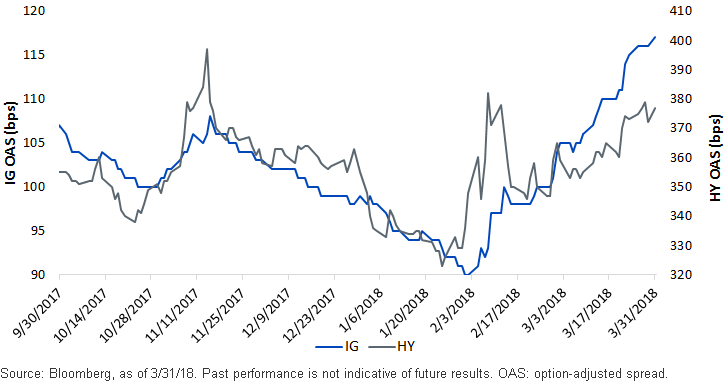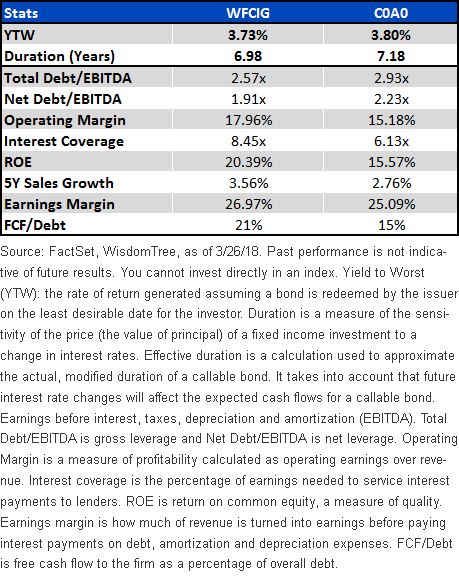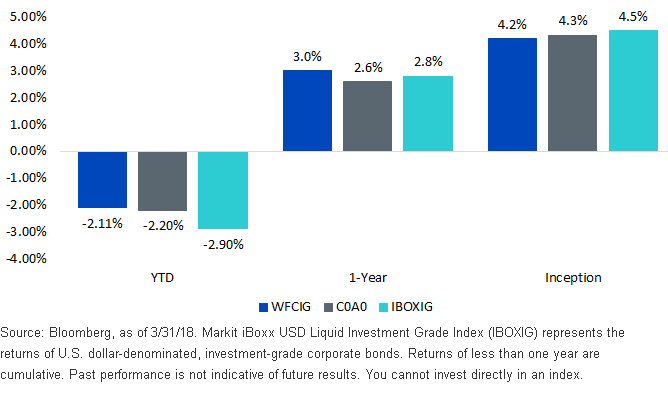If Focusing on Fundamentals, Buy the Dip in IG Credit



Over the last few weeks, several articles have been published about the implications of a widening in investment-grade (IG) credit spreads. As we show below, this widening primarily has been driven by technical factors rather than fundamentals. We believe now could be a particularly apt time to review the case for a fundamentally screened and income-tilted approach as the credit cycle matures.
After making fresh cycle lows in early February, IG credit1 spreads have widened by approximately 24 basis points (bps) over the last two months. In our view, if this was the beginning of the end for this credit cycle, we would have expected to see this move confirmed by a similar shift in high-yield (HY) credit2 spreads. Over long periods of time, IG and HY credit spreads tend to have a fairly strong correlation because credit spreads serve as a barometer of risk. When the economy is healthy, corporate bonds pose less risk of being downgraded or falling into distress. When the credit cycle is turning, spreads widen as investors sell out of risky debt. Curiously, the most recent move appears to have affected IG more than HY.
U.S. IG and HY Option Adjusted Spread

Balancing Supply and Demand
While financial media seeks to explain why markets react a certain way each day, the simple answer can largely be summed up by supply and demand. If the market goes up on a given day, there were likely more people looking to buy than sell. On days where prices fall, more people were looking to sell than buy.
In the case of IG fixed income, supply declined by 31% year-over-year in January.3 After touching some of the tightest levels since 2007, issuance started to ramp up in the first quarter (as it usually does). In February, supply ticked up 17% amid a general increase in macro volatility. In March, CVS raised $40 billion in new debt to finance its acquisition of Aetna, one of the biggest deals of last year.4 As supply continued to increase, investor appetite for new issues softened amid a general rise in yields. In fact, several companies issuing new debt over the past two months were forced to pay higher coupons to attract investors. With volatility picking up in other markets, softness in the market spread more broadly.
As tech firms right-size their financing mix after tax reform, it’s likely that we’ll see a general slowdown in bond issuance in the coming months. As a result, we would advocate buying the dip in the current market environment based on our view of fundamentals that we discuss below.
Contrasting Fundamentals
One of the key differences between WisdomTree’s approach to constructing fixed income indexes and simply weighting by market cap is that we seek to incorporate company fundamentals into our screening and weighting methodology. Through our research, we found that by focusing on free cash flow over debt service, leverage and profitability, we could meaningfully improve the risk-adjusted returns in IG fixed income. Below, we contrast some key fundamental metrics between market cap-weighting and our fundamental approach.
WisdomTree Fundamental U.S. Corporate Bond Index (WFCIG) vs. ICE BofAML US Corporate Index (C0A0)

Concerns about the current fixed income market largely boil down to three factors: leverage, capital efficiency and free cash flow. As we show in the table above, WisdomTree’s fundamental IG Index represents corporate bond issuers that are less dependent on leverage, that have higher margins, have much stronger return on equity (ROE) and generate higher free cash flow per unit of debt. Simply put, the companies represented in this Index are more-efficient and higher-quality companies. While WisdomTree believes owning quality late in the cycle makes sense, it’s also interesting that the WFCIG net yield remains comparable to that of a general market cap-weighted approach, despite having modestly lower duration. In our view, if we’re able to boost quality, reduce interest rate risk and maintain attractive levels of income, the WFCIG approach should compare favorably over a market cycle versus a cap-weighted approach.
Translating Fundamentals into Performance
One of the key risks of simply owning a higher-quality bond portfolio is that you’re likely to underperform because of lower yields. This is precisely why we sought to incorporate a second step to our process to boost yield after screening for fundamentals. As we show below, our fundamental IG approach has been able to provide comparable levels of return to larger competitors despite our bias to quality and lower-duration profile. Over the last year, U.S. interest rates have continued to rise as the Federal Reserve (Fed) sought to normalize policy. Year-to-date, we know that nominal rates have increased and credit spreads have widened. As a result, our quality approach has tended to outperform market cap as well as other longer duration indexes.
IG Fixed Income Returns, 2/29/16-3/31/18

In our view, as investors consider which risks are worth taking in fixed income, we believe our lower-duration quality approach makes sense for the current environment. While we remain favorably disposed to U.S. corporate credit, we would advocate a bias to quality as we go later in the cycle. Given that our base case is for a continuation of the move higher in rates, maintaining a slightly defensive poster on interest rate risk makes sense in the current environment.
1As proxied by the ICE BofAML US Corporate Index (C0A0).
2As proxied by the ICE BofAML US High Yield Index (H0A0).
3Source: Citi, as of 3/6/18.
4As of 3/31/18, the WisdomTree Fundamental U.S. Corporate Bond Index (WFCIG) had a 1.22% and .42% exposure to CVS and Aetna, respectively. For current holdings of WFCIG, click here.



